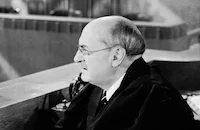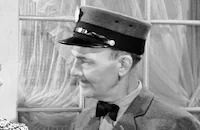Green Light

Brief Synopsis
Cast & Crew
Frank Borzage
Errol Flynn
Anita Louise
Margaret Lindsay
Sir Cedric Hardwicke
Walter Abel
Film Details
Technical Specs

Synopsis
When Newell Paige, a young surgeon at an urban hospital, takes the blame for a patient's death caused by his mentor, Dr. Endicott, Paige is asked to tender his resignation. Before leaving for western Montana to work on a cure for Rocky Mountain spotted fever with his friend, bacteriologist John Stafford, Paige meets and falls in love with Phyllis Dexter, the dead patient's daughter, who is attracted to him until she learns that he is the man considered responsible for her mother's death. In Montana, Paige tries to find meaning in life by working to discover a serum to combat the fever, using himself as a guinea pig for his experiments. Phyllis journeys to Montana on a mission of forgiveness just as Paige falls ill. Endicott, finally overcome by remorse, and Frances Ogilvie, a nurse who loves Paige, support Phyllis and Stafford in their vigil by Paige's bedside. Paige recovers and under the counsel of Rev. Dean Harcourt, has a religious experience. Stafford and Ogilvie stay in Montana to administer the new vaccine, while Paige is restored to the staff of his hospital, where he joins Phyllis in Harcourt's congregation.

Director

Frank Borzage
Cast

Errol Flynn

Anita Louise

Margaret Lindsay

Sir Cedric Hardwicke

Walter Abel

Henry O'neill

Spring Byington
Erin O'brien-moore

Henry Kolker

Pierre Watkin

Granville Bates
Russell Simpson
Myrtle Stedman
St. Luke's Choristers
Wade Boteler

John Butler
Jim Pierce

Bess Flowers
Noel Kennedy
Louise Stanley
Douglas Weed
Miki Morita
Shirley Lloyd
Lillian Elliott
Lyle Maraine
Jim Thorpe
Sibyl Harris
Sam Rice
Lowden Adams
Ed Chandler
James Farley
Milt Kibbee
Harvey Clark
Crew
Henry Blanke
Frank Borzage
Lew Borzage
Owen Crompton
Patricia Eckford
John Ellis
Robert Fellows
Leo F. Forbstein
Hugo Friedhofer
James Gibbons
Kathrine Grams
Paul Green
Oren Haglund
Byron Haskin
Frank Heath
Fred Jackman Jr.
H. F. Koenekamp
Jack Koffman
Milton Krims
Burrell Kring
Robert B. Lee
Jean Mcnaughton
Orry-kelly
Max Parker
Al Roberts
Max Steiner
Willard Van Enger
Jack L. Warner

Film Details
Technical Specs

Articles
Green Light
Self-sacrifice was big box office at the time, particularly in Universal's 1935 adaptation of Lloyd C. Douglas' Magnificent Obsession, the film that made Robert Taylor a star. It was only logical for Warner Bros. to option the rights to another of his books, a 1935 best-seller with a similar setting in the world of medicine. This time out, a young surgeon puts his career and love life at risk by taking the blame for an older surgeon's mistake, then tries to redeem himself through medical research. Through it all, a sympathetic Episcopal dean underlines the story's moral implications to anybody within earshot. A Lutheran minister, Douglas specialized in such uplifting tales, culminating with The Robe (1953), which would become one of 20th Century-Fox's top-grossing films.
Initially Warner Bros. had grandiose plans for the film adaptation. Leslie Howard and Robert Montgomery were both considered for the lead in Green Light. Instead, it became a change of pace for Flynn, only recently risen to stardom and in need of something to do between his more lavish adventure films. The studio proudly announced Green Light as "his first modern role." Flynn's most popular co-star, Olivia de Havilland, was initially suggested as his love interest, the daughter of the woman killed in surgery, but instead the part went to Anita Louise. Although one of Warner's' most beautiful female stars and a fixture in costume films like A Midsummer Night's Dream (1935) and Anthony Adverse (1936), Louise was not as dramatically adept as de Havilland. Ironically, she had been the first choice to co-star with Flynn in Captain Blood. The studio also considered Technicolor sequences but eventually dropped the idea.
In adapting the novel to the screen, writer Milton Krims necessarily had to shorten the most effective parts of the original novel, such as the long conversations between the dean and his many visitors that established the title, which was a reference to the green light at traffic intersections, a metaphor for the signs the universe gives to encourage the perfection of humanity. Instead, Krims played up the romantic plot, always the weakest part of Douglas' writing, and even upped the melodrama by having the young doctor test his research by inoculating himself with a deadly disease. The shift in focus was reflected in the advertising campaign, which pushed the romance angle, referring to the film as "an x-ray of unquestioning love" and "the story that made the world believe in love again."
In keeping with the film's romantic focus, Warner's hired one of Hollywood's most romantic directors, Frank Borzage. He had already scored a success at the studio, briefly revitalizing the team of Dick Powell and Ruby Keeler with the military musicals Flirtation Walk (1934) and Shipmates Forever (1935). They gave him the typical sterling supporting cast for a major studio production, with Sir Cedric Hardwicke enlivening the dean's sermons with a welcome touch of humor, Broadway veteran Walter Abel as Flynn's research assistant, Margaret Lindsay as a surgical nurse in love with Flynn and Spring Byington as Louise's doomed mother.
Most reviewers were quick to point out Green Light's structural problems and the uneven performances. Though the supporting cast won strong notices, the leads were less favorably received. Writing in the New York Times, Frank S. Nugent noted that "Errol Flynn is too much the swashbuckler to represent the brooding, sensitive, introspective Dr. Paige, and Anita Louise is both immature and pallid...."
Green Light did well at the box office, with audiences drawn in by Flynn's popularity. It turned up in a one-hour radio version on Lux Radio Theater in 1938 with Flynn and de Havilland. Warner's also considered a Technicolor remake in the '50s, but never got further than assigning the screenplay.
Producer-Director: Frank Borzage
Screenplay: Milton Krims
Based on the novel by Lloyd C. Douglas
Cinematography: Byron Haskin
Art Director: Max Parker
Music: Max Steiner
Cast: Errol Flynn (Dr. Newell Paige), Anita Louise (Phyllis Dexter), Margaret Lindsay (Frances Ogilvie), Sir Cedric Hardwicke (Dean Harcourt), Walter Abel (Dr. John Stafford), Henry O'Neill (Dr. Endicott), Spring Byington (Mrs. Dexter), Erin O'Brien-Moore (Pat Arlen), Henry Kolker (Dr. Lane), Granville Bates (Sheriff), Milton Kibbee (Other Man), Bess Flowers (Mrs. Dexter's Nurse), Jim Thorpe (Indian).
BW-86m. Closed Captioning.
by Frank Miller

Green Light
Quotes
Trivia
Notes
According to Warner Bros.' records, Leslie Howard and Robert Montgomery were candidates for the part of Dr. Paige. The files also indicate that Technicolor scenes were planned for the picture. Dr. Stimpert acted as an uncredited consultant. Radio Lux Theater broadcast a production of Green Light on January 31, 1938, directed by Cecil B. DeMille and starring Errol Flynn and Olivia de Havilland. Modern sources add the following information: Olivia de Havilland was considered for the part of "Phyllis Dexter." Warner Bros. planned a Technicolor remake in 1951 to be directed by Henry Blanke and written by Harold Medford. Modern sources add the following credit: Contr trmt Mary C. McCall, Jr.
















